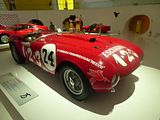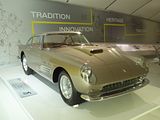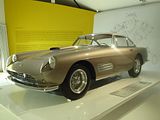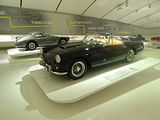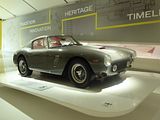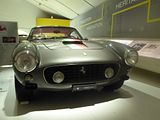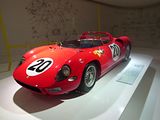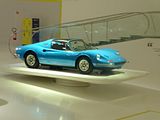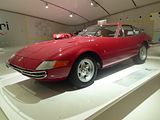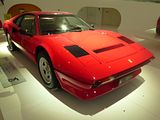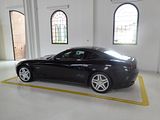The Museo Casa Enzo Ferrari, located in the centre of Modena, first opened in 2012. Complementing the Galleria Ferrari which is in Maranello, and is world famous, attracting vast crowds of visitors including lots of coach parties, this additional Ferrari museum provides not just a place to show more of the incredible cars and artefacts from the company’s history, but it is also significant as it is located not just in the city where Enzo was born in 1898, but because it includes the building that constituted his father’s workshop. This has been restored on the outside and completed refitted on the inside to allow for a lot of display space. A new and rather striking building was constructed alongside it, and this houses the main part of the museum, as well as the expected cafe and gift shop. The site is in the middle of the town, a few hundred yards from the Maserati factory, and easily accessible from the A4 autostrada which goes from Bologna west to Milano, as well as being a matter of a few metres from Modena railway station. The emphasis here is on quality rather than quantity, with around 18 vehicles beautifully displayed in the annex that was built as part of the reopening of the site in 2012, and the adjoining and older building, once the Ferrari family workshop, contains mainly a series of historic Ferrari engines, along with a few further race cars. Since that 2012 opening, the displays have been changed more or less on an annual basis, so it this is one of those museums that it is well worth returning to whenever in the area, as I have done on an annual basis since 2014. The only exception being 2021, as the displays that were set up in 2020 just before lockdown persisted for both 2020 and 2021. New displays were created in February 2022, though, so when I had a few days vacation in Italy in June 2022, I went along to have a look. For 2022, there are two anniversaries to celebrate: the 10th of the museum and the 75th of Ferrari and the displays reflect both. The main building marks 75 years of the Ferrari marque with a display of cars called “Ferrari Forever”.
166 Inter Stabilimenti Pinin Farina: The Ferrari 166 Inter was Ferrari’s first true grand tourer. An evolution of the 125 S and 166 S racing cars, it was a sports car for the street with coachbuilt bodies. The Inter name commemorated the victories claimed in 166 S models by Scuderia Inter. 38 166 Inters were built from 1948 through 1950. Note that both the 166 S and 166 F2 were also called “166 Inter” in the days that they were actively raced by the Scuderia of the same name. The 166 Inter shared its Aurelio Lampredi-designed tube frame, double wishbone/live axle suspension, and 2,420 mm (95.3 in) wheelbase with the 125 S and 166 S. It was replaced by the 2.3 L 195 Inter in 1950. The first Ferrari GT car debuted at the Paris Motor Show on October 6, 1949. It was an elegant coupé designed by Carrozzeria Touring of Milan who had previously created a number of similar Ferrari and Alfa Romeo models. Customer sales soon started, with 166 Inter models becoming the first Ferraris to be purchased for the road rather than the race track. As was typical at the time, a bare chassis was delivered to the coachbuilder of the customer’s choice. Majority used Touring with coupé or barchetta style. Carrozzeria Ghia produced one-off coupé designed by Felice Mario Boano. Others were built by Stabilimenti Farina, who penned coupés and cabriolets. Bertone bodied one cabriolet. Vignale also joined in with seven bodyworks, presaging their designs of the coming decade, foreshadowed those companies’ later involvement with Ferrari. The 2.0 L Gioacchino Colombo-designed V12 engine from the 166 S remained, as did its chassis, though the wheelbase would eventually grow from 2,420 mm (95.3 in) to 2,500 mm (98.4 in) and even 2,620 mm (103.1 in). Output was 90 PS at 5600 rpm with one carburetor and top speed of 150 km/h (93 mph). Just 38 of these cars were built.
375MM Carrera Panamerica: The Ferrari 375 MM, was a sports racing car produced in 1953 up to 1955 for the road cars. It was named “375” for the unitary displacement of one cylinder in the 4.5 L V12 engine, and the “MM” stood for the Mille Miglia race. In total 26 units were made, including four converted from the 340 MM. The first prototype was a Vignale Spyder and three next cars were Pinin Farina Berlinettas, all converted from the Ferrari 340 MM. Majority of the cars would be bodied by Pinin Farina in a spider style. The engine was based on its Ferrari 375 F1 counterpart, but with shorter stroke and bigger bore, for the customer cars and unchanged for the factory ones. Perhaps the most known 375 MM is the Pininfarina “Bergman Coupe”, s/n 0456AM, commissioned in 1954 by director Roberto Rossellini for his wife, actress Ingrid Bergman. Rossellini also owned another 375 MM spyder, s/n 0402AM, which sustained a crash and was rebodied into a coupe by Scaglietti. The Scaglietti coupe was subsequently bought by the Microsoft executive Jon Shirley and restored by Ferrari specialist Butch Dennison. It would later become the first postwar Ferrari to win Best of Show at the Pebble Beach Concours d’Elegance. The list of notable examples also includes a coupé created by Carrozzeria Ghia to a Giovanni Michelotti design. It was the last Ferrari ever to be bodied by this Turinese coachbuilder. The car was presented at the Torino Motor Show and the New York Auto Show, both in 1955. The 375 MM was available with two different engines, both of around 4.5 L capacity. One was for customer cars and the other for the factory teams. Factory race drivers received a straight derivative of the Formula One unit from the 375 F1. Designated as the tipo 102, it had the same total capacity of 4493.73 cc from the same internal measurements as the 375 F1, at 80 by 74.5 mm of bore and stroke. The new updated engine, codenamed as the tipo 108, was reserved for the customer cars. The engine had a changed capacity of 4522.68 cc, thanks to its 84 by 68 mm of bore and stroke, and would also be mounted in the 375 America road car. Both versions used three Weber 40IF/4C or 42DCZ carburettors and could produce 340 PS at 7000 rpm. The chassis was of a tipo 102 designation and was derived from its predecessor, the 340 MM, also made out of welded steel tubes. Wheelbase was slightly longer than before, now at 2,600 mm (102.4 in). The suspension setup was also inherited from the 340 MM, but with an addition of the Houdaille-type hydraulic shock absorbers in the front and rear. Although intended for the Mille Miglia, the 375 MM was also raced with limited success in the Carrera Panamericana, scoring fourth place in 1953 and finishing second in 1954. Other major successes in 1953 included overall wins at Spa 24 Hours, driven by Giuseppe Farina and Mike Hawthorn duo, 12 Hours of Pescara with Hawthorn and Umberto Maglioli and 12 Hours of Casablanca, won by Farina and Piero Scotti. The 375 MM with Alberto Ascari and Luigi Villoresi, was contesting the 1953 24 Hours of Le Mans alongside its 4.1-litre siblings, to no avail due to a clutch problems. In the 1000 km Nürburgring race of 1953, the 375 MM scored another victory with Giuseppe Farina, this time aided by Alberto Ascari. This race along with Spa 24 Hours counted towards the 1953 World Sportscar Championship, won for Ferrari in due honour to the 375 MM. In 1954 in Argentina, Giuseppe Farina with Umberto Maglioli won the 1000 km Buenos Aires, that was a championship race. On 760 km track of Coppa della Toscana, Piero Scotti won in the 375 MM ahead of Gordini. Later, the 375 MM competed in races in Europe, South and North Americas, winning many of them. The car did not score any more championship points as it was replaced by a bigger displacement derivative, the 375 Plus.
250 Tour de France: The original 250 GT Berlinetta, nicknamed the “Long Wheelbase Berlinetta”, was also called the “Tour de France” after competing in the 10-day Tour de France automobile race, which the car won in 1956, 157 and 1958. Seventy-seven Tour de France cars were built, of which a number were sold for GT races from 1956 through 1959. Construction was handled by Carrozzeria Scaglietti based on a Pinin Farina design. The engine began at 240 PS but eventually rose to 260 PS. Pirelli Cinturato 165R400 tyres (CA67) were standard. At the 1956 Geneva Motor Show, Scaglietti displayed their own 250 GT prototype, which became known as the limited-production, Series I, “no-louvre” 250 GT Berlinetta. The first customer car was built in May 1956, with production now the responsibility of Scaglietti in Modena. Fourteen “no-louvre” and nine “14-louvre” Series I and II Berliettas were made. There were four series of 250 GT Berlinettas. In mid-1957 the Series III cars were introduced, with three louvres and covered headlights. Eighteen were produced. The 36 Series IV cars; retained the covered headlights and had a single vent louvre. Zagato also made five “no-louvre” superlight cars to Ugo Zagato’s design.
410 SuperAmerica: Recognising the ever increasing importance of America for sales, Ferrari produced a line of America cars, beginning with the 1955 410 Superamerica. The engine, based on a single plug 410 S powerplant, was now up to 5.0 L with 340 PS (335 bhp) at 6,000 rpm produced thanks to triple Weber 40DCF carburettors. A 1957 Superamerica series III had triple 46DCF3 Webers for even more power (360 PS (355 bhp)) and was also the final development for the ‘long-block’ Lampredi V12. Each 410 Superamerica had custom bodywork, with a few by Boano and Ghia but most by Ferrari stalwart, Pinin Farina. The price was extremely high—at US$16,800, the 410 Superamerica offered at the New York Auto Show by importer Luigi Chinetti was more than twice as expensive as the Mercedes-Benz 300SL “Gullwing” exhibited by Max Hoffman. Just 35 were built when the series ended in 1959. First 2 series of Pinin Farina coupés were very similar with only 3rd series radically redesigned with non-panoramic rear window, different side-line, lower front grille and more recessed headlights, some covered. While most 3rd series PF coupés had 3 louvres behind side-windows, some have this space glassed over. Series III cars were introduced in 1958.
250 GT Cabriolet Series II: Released at the Geneva Motor Show in 1957, the original 250 GT Cabriolet Pinin Farina Series I used the 2,600 mm (102.4 in) wheelbase and the body was styled differently from the Berlinetta. Cars left the factory on either 165R400 or 185VR16 Pirelli Cinturato tyres (CA67). About 36 examples were produced before a second series was shown at Paris in 1959. These later cars had more in common with the production Berlinetta. About 200 of the Series II cars were built.
250 GT SWB (“Passo Corto”): One of the better known early Ferraris, examples of this model are to be seen at historic motor racing events as well as concours events. First seen in 1959, the 250 GT Berlinetta SWB used a short 2,400 mm (94.5 in) wheelbase for better handling. Of the 176 examples built, both steel and aluminium bodies were used in various road (“lusso”) and racing trims. Engine output ranged from 237 bhp to 276 bhp. Development of the 250 GT SWB Berlinetta was handled by Giotto Bizzarrini, Carlo Chiti, and young Mauro Forghieri, the same team that later produced the 250 GTO. Disc brakes were a first in a Ferrari GT, and the combination of low weight, high power, and well-sorted suspension made it a competitive offering. It was unveiled at the Paris Motor Show in October and quickly began selling and racing. The SWB Berlinetta claimed GT class of the Constructor’s Championship for Ferrari in 1961. These cars are highly prized nowadays and for good reason
250LM: At the November 1963 Paris Auto Show, Ferrari introduced the 250 LM (Le Mans). It was developed as a coupé version of the 250 P and was ostensibly a new production car intended to meet FIA homologation requirements for the Group 3 GT class. The intention was for the 250 LM to replace the 250 GTO as Ferrari’s premier GT-class racer. However, in April 1964 the FIA refused to homologate the model, as Ferrari had built considerably fewer than the required 100 units. The 250 LM thus had to run in the prototype class until it was homologated as a Group 4 Sports Car for the 1966 season. 32 total 250 LM chassis were built from 1963 to 1965, with all but the first chassis (s/n 5149, the Paris Auto Show car with a 250 P engine) powered by 3.3-litre 320 bhp (238 kW) engines as used in the 275 P. According to Ferrari naming convention, the 3.3 litre cars should have been designated “275 LM”, however Enzo Ferrari insisted that the name remain 250 LM in order to facilitate the homologation process. The 250 LM shared fully independent double wishbone suspension, rack and pinion steering, four wheel disc brakes and 5-speed transaxle with the 250 P, however the tubular space frame chassis was significantly strengthened with the roof structure, additional cross-bracing and heavier gauge tubing. The interior was trimmed out as a nod to the ostensible production status of the car, but ultimately it was little different from a prototype racer. The 250 LM was successfully raced around the world by both factory-supported and privateer racers. Unlike the 250/275/330 P cars, new 250 LMs were sold to private customers and campaigned by privateer teams. From 1964 through 1967, 250 LMs were raced by Scuderia Ferrari, NART, Maranello Concessionaires, Ecurie Filipinetti, Ecurie Francorchamps and others, even when this model was no longer competitive with the latest factory prototypes.[23][20][24] Notably, a 250 LM (chassis 5893) entered by the North American Racing Team won the 1965 24 Hours of Le Mans driven by Jochen Rindt and Masten Gregory. This remains Ferrari’s last overall victory in the endurance classic. This car is now owned by the Indianapolis Motor Speedway Museum and was displayed at the 2004 Pebble Beach Concours d’Elegance and the 2013 Amelia Island Concours d’Elegance. The 250 LM is highly sought-after by serious auto collectors and individual cars are often featured at auctions, car shows and historic racing events. 250 LMs typically sell for more than $10 million USD and auction records for this model have been repeatedly broken in the past 10 years.
275P: For the 1964 season, Ferrari developed the 275 P and 330 P. These were improved versions of the 250 P with larger displacement engines and slightly modified bodywork. The tubular space-frame chassis and most other components remained the same as in the 250 P. The 275 P used a bored-out 3.3L version of the 250 Testa Rossa-type engine originally utilized by the 250 P. The 330 P used a different design, a 4.0L Colombo-designed V12 based on engines used in the 400 Superamerica road cars. The 330 P developed more power than the 275 P (370 bhp vs 320 bhp) but weighed more (785 kg vs 755 kg). Some drivers preferred the extra power of the 330 P while others appreciated the more nimble feel of the 275 P and the two models were raced concurrently. Production of these types included three brand new chassis and conversions of all four 250 P chassis. It is not possible to clearly determine the number of chassis produced with each engine type as 275 and 330 engines were swapped as needed between cars. 275 P and 330 P cars were actively and successfully raced by Scuderia Ferrari, NART and Maranello Concessionaires during 1964 and 1965 seasons. The most notable result was a 1-2-3 sweep at the 1964 24 Hours of Le Mans. The Scuderia Ferrari-run 275 P driven by Guichet and Vaccarella took first, followed by a Maranello Concessionaires 330 P (Hill/Bonnier) in second and a Scuderia Ferrari 330 P (Bandini/Surtees) in third.
275 GTB: This is a 275 GTB, one of those Ferrari models whose price tag generally runs into 7 figures when it is offered for sale these days. The 275 was a series of two-seat front-engined V12-powered models produced in GT, roadster, and spyder form by Ferrari between 1964 and 1968. The first Ferrari to be equipped with a transaxle, the 275 was powered by a 3286 cc Colombo 60° V12 engine that produced 280-300 hp. Pininfarina designed the GT and roadster bodies, Scaglietti the rare NART Spyder, among the most valuable of all Ferraris made. The standard 275 GTB coupe came first. It was produced by Scaglietti and was available with 3 or 6 Weber twin-choke carburettors. It was more of a pure sports car than the GT name suggested. Some cars were built with an aluminium body instead of the standard steel body. A Series Two version with a longer nose appeared in 1965. The 275 GTB/4 debuted in 1966. A much updated 275 GTB, it generated 300 bhp from a substantially reworked 3286 cc Colombo V12 engine, still with two valves per cylinder but now with a four-cam engine and six carburettors as standard. In a departure from previous Ferrari designs, the valve angle was reduced three degrees to 54° for a more-compact head. The dual camshafts also allowed the valves to be aligned perpendicular to the camshaft instead of offset as in SOHC engines. It was a dry-sump design with a huge 17 qt (16 litre) capacity. The transaxle was also redesigned. A torque tube connected the engine and transmission, rather than allowing them to float free on the body as before. This improved handling, noise, and vibration. Porsche synchronizers were also fitted for improved shifting and reliability. The 275 GTB/4 could hit 268 km/h (166.5 mph). With new bodywork, it was the first Ferrari to not be offered with wire wheels. A total of 280 were produced through to 1968 when it was replaced by the 365 GTB/4 Daytona
275 GTS: The 275 GTS was a two-seat grand touring spider produced from 1964 to 1966. The 275 GTS was introduced at the same time as the 275 GTB and was mechanically almost identical, sharing the 3.3 litre V12, transaxle, chassis and fully independent suspension. Ferrari reported that the engine fitted to the 275 GTS produced 260 bhp. This was less than the reported 280 bhp produced by the 275 GTB, although there was likely no difference in engines between the models. The 275 GTS was never equipped with a torque tube, unlike the 275 GTB series II. This model was fitted with 205Vr15 Pirelli Cinturato CN72 tyres on Borrani wire wheels. The all steel 275 GTS body was designed and manufactured by Pininfarina. Its appearance was entirely different than that of the 275 GTB coupé, with a shorter front hood, smaller uncovered headlights, and overall balanced proportions suggesting earlier 250 Pininfarina Cabriolet models. All 275 GTS were equipped with a folding cloth convertible top and an additional removable hard top was a factory option. Ferrari produced a total of 200 275 GTS between late 1964 and early 1966, including 19 in right hand drive. The 275 GTS was replaced in 1966 by the 330 GTS, leaving no 3.3 L spider in the range until the creation of the 275 GTB/4 NART Spider.
246 GT Dino: Still seen by many as the most beautiful Ferrari ever built was the 246 GT Dino and there were examples of the closed roof and the Spider version here. The Ferrari Dino was created to honour Alfredo ‘Dino’ Ferrari, Enzo Ferrari’s only legitimate son, who sadly died of muscular dystrophy in 1956. Unlike any previous road-going Ferrari, the Dino utilised a V6 engine, the Tipo 156, which Alfredo himself had helped develop and strongly advocated during his working life. Following continued motor racing success and in order to homologate Ferrari’s 1966 Formula Two campaign, a new line of mid-engined production V6 coupés with Fiat running gear went on sale in 1967 in two litre 206 GT form. However, in 1969 a larger 2.4 litre Dino was introduced, named the 246 GT or GTS in the case of the Spider. Only 3,913 definitive Dinos were built before the introduction of the completely restyled V8 engined 308 in 1973. The voluptuous bodywork of the 246, which many regard as the prettiest ever to grace a road-going Ferrari, was designed by Pininfarina and built by Scaglietti. It clothed a tubular chassis which carried wishbone independent suspension at each corner. The compact four-cam, 190bhp. engine was mounted transversely above the five-speed gearbox and just ahead of the rear axle, allowing for both a comfortable cockpit and some usable boot space.
365 GTB/4 “Daytona”: The Ferrari 365 GTB/4 Daytona probably needs little introduction. A Gran Turismo automobile produced from 1968 to 1973, it was first introduced to the public at the Paris Auto Salon in 1968 and replaced the 275 GTB/4. The Daytona was replaced by the mid-engined 365 GT4 Berlinetta Boxer in 1973. Early cars, such as this 1970 example had the plexi-glass front end, before a revised design with pop-up headlights was adopted. The generally accepted total number of Daytonas from the Ferrari club historians is 1,406 over the life of the model. This figure includes 158 right-hand-drive coupés, 122 factory-made spyders (of which 7 are right hand drive), and 15 competition cars in three series with modified lightweight bodies and in various degrees of engine tune. All bodies except the first Pininfarina prototype were produced by Scaglietti As well as the road car, there was a 365 GTB/4C. Three series of client competition cars were built at the factory’s “assistenza clienti” department in Modena. The first were built in 1971 with full aluminium bodies. The second, in early 1972 had steel bodies with aluminium opening panels and extended wheelarches to allow wider wheels and tyres to be fitted. The third, in 19673 were similar but has steel doors. The care were successful in the GT category at Le Mans in 1972 filling the top five positions in their class and they claimed class wins in 1973 and 1974. This is a second series car.
308 GTB and 208 GTB Turbo: The 308 GTB was launched at the Paris Motor Show in 1975 as a direct replacement for the Dino 246. Designed by Pininfarina with sweeping curves and aggressive lines, the 308 has gone on to become one of the most recognised Ferraris of all time. Fitted with a 2.9 litre DOHC V8 engine fed by four Webber 40DCNF Carburettors, the power output of 255bhp was sufficient to propel the 308 from 0 to 60 mph in 6.5 seconds and on to a top speed of 159 mph. Tougher emissions standards in the 1980s challenged Ferrari more than many other marques. In 1980, fuel injection was adopted for the first time on the 308 GTB and GTS models, and power dropped quite noticeably fro 240 bhp to 214bhp. Two years later, at the 1982 Paris Motor Show, Ferrari launched the 308 quattrovalvole, in GTB and GTS form. The main change from the 308 GTBi/GTSi it succeeded were the 4-valves per cylinder—hence its name, which pushed output back up to 240 hp restoring some of the performance lost to the emission control equipment. The new model could be recognised by the addition of a slim louvred panel in the front lid to aid radiator exhaust air exit, power operated mirrors carrying a small enamel Ferrari badge, a redesigned radiator grille with rectangular driving lights on each side, and rectangular (in place of round) side repeaters. The interior also received some minor updates, such as a satin black three spoke steering wheel with triangular centre; cloth seat centres became available as an option to the standard full leather. Available included metallic paint, a deep front spoiler, air conditioning, wider wheels, 16-inch Speedline wheels with Pirelli P7 tyres, and a satin black roof aerofoil (standard on Japanese market models). Apart from the 32-valve cylinder heads, the V8 engine was essentially of the same design as that used in the 308 GTSi model. The gear and final drive ratios were altered to suit the revised characteristics of the four valves per cylinder engine. One other significant benefit of the QV four valve heads was the replacement of the non-QV models sodium valves which have been known to fail at the joint between the head and the stem. Bosch K-Jetronic fuel injection and Marelli Digiplex electronic ignition were carried over from the GTBi/GTSi. The car was produced in this form until the launch of the 328 models in the autumn of 1985 which had larger 3.2 litre engines and a number of styling changes. 308 GTB models are becoming increasingly sought after, with prices rising steadily and quite steeply.
550 Barchetta: This was a fully open-topped version of the regular 550 Maranello and was introduced at the Paris Motor Show in 2000. The 550 Barchetta Pininfarina was a true roadster with no real convertible top provided. The factory did provide a soft top, but it was intended only for temporary use as it was cautioned against using the top above 70 mph (110 km/h), and when you look at what appears to be a rather “Heath Robinson” style piece of canvas anchored over the cabin, you can see why. A total of 448 Barchettas were produced, four more than initially planned due to concerns of superstition in the Japanese market.
500 Mondial: This is a body former for the 500 Mondial. The early experiments with Lampredi’s four-cylinder engine led to the creation of the famed 500 Mondial. Named to mark the world (“Mondial”) championships won by Alberto Ascari, the 500 Mondial featured a 2.0 L version of Lampredi’s four-cylinder engine in a small and light body with an advanced suspension. The car debuted on December 20, 1953 at the 12 Hours of Casablanca driven by Ascari and Luigi Villoresi, placing second to a 375 MM. In 1954 four 500 Mondials were entered in Mille Miglia race, with best result being second overall after Lancia D24.[5] The Mondial remained competitive through the end of the decade, including an entry in the 1957 Mille Miglia, and was raced as late as 1962, when Javier Valesquez entered chassis 0448MD in the 1962 Carrera Presidential race in Mexico City. The 500 Mondial’s 1984 cc engine was taken from the 500 F2 which won the world championship but was detuned to produce 170 bhp. It was extremely light at 720 kg (1,590 lb). and handled well with a modern de Dion tube rear suspension. The first 500 Mondials were spiders bodied by Pinin Farina, but Carrozzeria Scaglietti later created a series of barchettas. Two berlinettas were also built by Pinin Farina. 29 were built in total. Of the 13 Pininfarina spiders built, 5 were the earlier Series I version with covered headlights. The car won the prestigious Gran Turismo Trophy at the 2012 Pebble Beach Concours d’Elegance, meaning it will eventually be re-created for use in Gran Turismo 6.
Depending on when you arrive, you may have to wait a few minutes for entry. The reason for this is because about every 30 minutes, the lights dim, and a video is projected on the wall above the main entrance. It lasts about 10 minutes and covers the life of Enzo Ferrari and his legacy with some wonderful periodic footage. Needless to say the climax has the audio backing of Luciano Pavarotti singing Puccini’s famous “Nessum Dorma”. It is impossible not to be moved as the video reaches its climax saying “Grazie Enzo”. I’ve seen it several times now, and it still moves me greatly
The second building on site, the restored Ferrari workshop, houses a collection of engines and on this occasion a further display of road cars.
The engine display is particularly impressive, with long lines of what has been the heart of every Ferrari over those 7.5 decades. They are grouped together so there are lines of V8 and V12 units from the road cars and some of the Formula 1 engines as well.
In addition, there are a six cars in here that featured in one of the special displays that have been held over those 10 years since this museum opened.
612 Scaglietti: Follow on to the 456GT was the 612 Scaglietti. Launched in 2004, this large 4 seater would be produced until 2011 when it was replaced by the FF. It never quite hit the spot for many people and the fact that Ferrari made few changes to it during its life makes you wonder if they really loved it like some of the other models in the range.
Maserati Quattroporte 1: The original Maserati Quattroporte (Tipo AM107) was built between 1963 and 1969. It was a large saloon powered by V8 engines—both firsts for a series production Maserati. The task of styling the Quattroporte was given to Turinese coachbuilder Pietro Frua, who drew inspiration from a special Maserati 5000 GT (chassis number 103.060) he had designed in 1962 for Prince Karim Aga Khan. While the design was by Frua, body construction was carried out by Vignale. The Quattroporte was introduced at the October-November 1963 Turin Motor Show, where a pre-production prototype was on the Maserati stand next to the Mistral coupé. Regular production began in 1964. The Tipo 107 Quattroporte joined two other grand tourers, the Facel Vega and the Lagonda Rapide, capable of travelling at 200 km/h (124 mph) on the new motorways in Europe. It was equipped with a 4.1-litre V8 engine, producing 260 hp at 5,000 rpm, and either a five-speed ZF manual transmission or a three-speed Borg Warner automatic on request. Maserati claimed a top speed of 230 km/h (143 mph). The car was also exported to the United States, where federal regulations mandated twin round headlamps in place of the single rectangular ones found on European models. Between 1963 and 1966, 230 units were made. In 1966, Maserati revised the Tipo 107, adding the twin headlights already used on the U.S. model. A leaf-sprung solid axle took place of the previous De Dion tube. The interior was completely redesigned, including the dashboard which now had a full width wood-trimmed fascia. In 1968 alongside the 4.1-litre a 4.7-litre version became also available (AM107/4700), developing 286 bhp. Top speed increased to a claimed 255 km/h (158 mph), making the Quattroporte 4700 the fastest four-door sedan in the world at the time. Around 500 of the second series were made, for a total of 776 Tipo 107 Quattroportes. Production ended in 1969.
166 Inter Touring Coupe: quite a contrast, visually, from the 166 Inter seen in the other building, this one has a Touring body on it.
F40: The F40 of 1987 was the successor to the 288 GTO. It was designed to celebrate Ferrari’s 40th anniversary and was the last Ferrari automobile personally approved by Enzo Ferrari. At the time it was Ferrari’s fastest, most powerful, and most expensive car for sale. As soon as the 288 GTO was launched, Ferrari started the development of an evolution model, intended to compete against the Porsche 959 in FIA Group B. However, when the FIA brought an end to the Group B category for the 1986 season, Enzo Ferrari was left with five 288 GTO Evoluzione development cars, and no series in which to campaign them. Enzo’s desire to leave a legacy in his final supercar allowed the Evoluzione program to be further developed to produce a car exclusively for road use. In response to the quite simple, but very expensive car with relatively little out of the ordinary being called a “cynical money-making exercise” aimed at speculators, a figure from the Ferrari marketing department was quoted as saying “We wanted it to be very fast, sporting in the extreme and Spartan,” “Customers had been saying our cars were becoming too plush and comfortable.” “The F40 is for the most enthusiastic of our owners who want nothing but sheer performance. It isn’t a laboratory for the future, as the 959 is. It is not Star Wars. And it wasn’t created because Porsche built the 959. It would have happened anyway.” Power came from an enlarged, 2936 cc version of the GTO’s twin IHI turbocharged V8 developing 478 bhp. The F40 did without a catalytic converter until 1990 when US regulations made them a requirement for emissions control reasons. The flanking exhaust pipes guide exhaust gases from each bank of cylinders while the central pipe guides gases released from the wastegate of the turbochargers. Engines with catalytic converters bear F120D code. The suspension was similar to the GTO’s double wishbone setup, though many parts were upgraded and settings were changed; the unusually low ground clearance prompted Ferrari to include the ability to raise the vehicle’s ground clearance when necessary. The body was an entirely new design by Pininfarina featuring panels made of Kevlar, carbon fibre, and aluminium for strength and low weight, and intense aerodynamic testing was employed. Weight was further minimised through the use of a plastic windscreen and windows. The cars did have air conditioning, but had no sound system, door handles, glove box, leather trim, carpets, or door panels. The first 50 cars produced had sliding Lexan windows, while later cars were fitted with wind down windows. The F40 was designed with aerodynamics in mind. For speed the car relied more on its shape than its power. Frontal area was reduced, and airflow greatly smoothed, but stability rather than terminal velocity was a primary concern. So too was cooling as the forced induction engine generated a great deal of heat. In consequence, the car was somewhat like an open-wheel racing car with a body. It had a partial undertray to smooth airflow beneath the radiator, front section, and the cabin, and a second one with diffusers behind the motor, but the engine bay was not sealed. Nonetheless, the F40 had an impressively low Cd of 0.34 with lift controlled by its spoilers and wing. The factory never intended to race the F40, but the car saw competition as early as 1989 when it debuted in the Laguna Seca Raceway round of the IMSA, appearing in the GTO category, with a LM evolution model driven by Jean Alesi, finishing third to the two faster space-framed four wheel drive Audi 90 and beating a host of other factory backed spaceframe specials that dominated the races. Despite lack of factory backing, the car would soon have another successful season there under a host of guest drivers such as Jean-Pierre Jabouille, Jacques Laffite and Hurley Haywood taking a total of three second places and one third. It would later be a popular choice by privateers to compete in numerous domestic GT series. Although the original plan was to build just 400 cars, such was the demand that in the end, 1311 were built over a 4 year period.
FF: The Ferrari FF (FF meaning “Ferrari Four”, for four seats and four-wheel drive, the Type F151) is a grand tourer presented by Ferrari on March 1, 2011 at the Geneva Motor Show as a successor to the 612 Scaglietti and is Ferrari’s first production four-wheel drive model. The body style has been described as a shooting-brake, a type of sporting hatchback/estate car with two doors. With a top speed of f 335 km/h (208 mph) and it accelerates from 0 to 100 km/h (62 mph) in 3.7 seconds, Ferrari stated that the FF was the world’s fastest four-seat automobile upon its release to the public. At the time of its reveal, the Ferrari FF had the largest road-going Ferrari engine ever produced: an F140 EB 6,262 cc naturally aspirated direct injected 65° V12, which produced 660 PS (485 kW; 651 hp) at 8,000 rpm and 683 N⋅m (504 lb⋅ft) of torque at 6000 rpm. The FF is equipped with a 7-speed dual-clutch transmission and paddle shift system similar to the California, the 458 Italia, and the Ferrari F12berlinetta. The new four-wheel drive system, engineered and patented by Ferrari, is called 4RM: it is around 50% lighter than a conventional system, and provides power intelligently to each of the four wheels as needed. It functions only when the manettino dial on the steering wheel is in the “comfort” or “snow” positions, leaving the car most often in the traditional rear wheel drive layout. Ferrari’s first use of 4RM was in a prototype created in the end of the 80s, called 408 4RM (abbreviation of “4.0 litre, 8 cylinder, 4 Ruote Motrici”, meaning “four-wheel drive”). This system is based around a second, simple, gearbox (gears and other components built by Carraro Engineering), taking power from the front of the engine. This gearbox (designated “power take off unit”, or PTU) has only two forward gears (2nd and 4th) plus reverse (with gear ratios 6% taller than the corresponding ratios in the main gearbox), so the system is only active in 1st to 4th gears. The connection between this gearbox and each front wheel is via independent Haldex-type clutches, without a differential. Due to the difference in ratios “the clutches continually slip” and only transmit, at most, 20% of the engine’s torque. A detailed description of the system (based on a conversation with Roberto Fedeli, Ferrari’s technical director) has been published. The FF shares the design language of contemporary Ferraris, including the pulled-back headlights of the 458 Italia, and the twin circular taillights seen on the 458 as well as the 599 GTB Fiorano. Designed under the direction of Lowie Vermeersch, former Design Director at Pininfarina, and Flavio Manzoni, Ferrari’s Styling Centre, work on the shooting brake concept initially started following the creation of the Sintesi show car of 2007. Distinctive styling elements include a large egg-crate grille, defined side skirts, and four exhaust tips. The shooting brake configuration is a departure from the conventional wedge shape of modern Ferraris, and the FF has been likened to the similarly-shaped 1962 Ferrari 250 GT SWB Drogo race car. The combination of hatchback-like shooting-brake design and collapsible rear seats gives the Ferrari FF a boot capacity of between 16 and 28 cu ft. Luxury is the main element of the interior and the use of Leather is incorporated throughout, just like the predecessors of the FF. Creature comforts like premium air conditioning, GPS navigation system, carpeting and sound system are also used. An updated version. called the GTC4 Lusso was launched in 2016 by which 2291 examples had been built.
F2003-GA: The Ferrari F2003-GA was a highly successful car used by Scuderia Ferrari in the 2003 Formula One World Championship. The chassis was designed by Rory Byrne, Ignazio Lunetta, Aldo Costa, Marco Fainello, Nikolas Tombazis and James Allison with Ross Brawn playing a vital role in leading the production of the car as the team’s Technical Director and Paolo Martinelli assisted by Giles Simon leading the engine design and operations.Its development was based on the previous Ferrari F2002, but featured new bulbous sidepods and a lengthened wheelbase to aid aerodynamics. The engine and gearbox were developed versions of the previous model. The car was designated “GA” as a mark of respect to Gianni Agnelli, the recently deceased head of Fiat. The car was introduced just before mid season in 2003, as the F2002 was seen as good enough to be competitive whilst the F2003-GA was developed further. The car was fast and competitive as it won 3 out its first 4 races, but had a tendency to overuse its tyres, which led to several late race tyre problems in mid seasons, causing a slight drop in form during the unusually hot European summer. As a result, Williams and McLaren were able to mount a consistent challenge to Ferrari and push Michael Schumacher for the championship. After Bridgestone engineers discovered Michelin were using tyres which changed construction, causing the French tyre maker to provide remoulded tyres late in the season. Ferrari became competitive again as it won the final 3 races of the season, and were able to hold off both Williams and McLaren for the Constructors’ Championship, whilst Schumacher snatched his sixth Drivers’ title, breaking Juan Manuel Fangio’s record which had stood for 46 years. The car won seven races, five pole positions, and five fastest laps before being replaced with the dominant F2004 in 2004, a car which was almost identical to its predecessor. On 11 December 2003, after the season had finished, Michael Schumacher raced the car against a Eurofighter Typhoon of the Italian Air Force over several measured distances to determine which was faster, the aircraft or the car. The German won the first run, over the distance of 600 metres, thanks to the weight advantage of his car over the jet, but the Typhoon won the two remaining runs over the longer distances of 900 and 1200 metres, winning the overall race.
Il Commendatore’s office: the last room in the building that you see on the way out is a recreation of Enzo’s office complete with a number of artifacts associated with the great man.
This remains a captivating place. There may be only 18 cars on show, but it is well worth the entry fee. If you go to the Galleria Ferrari in nearby Maranello as well, you can buy a combined ticket for the two, which is cheaper than buying individual admissions for each. More details can be found on the museum’s own website: https://www.ferrari.com/en-EN/museums/enzo-ferrari-modena




















